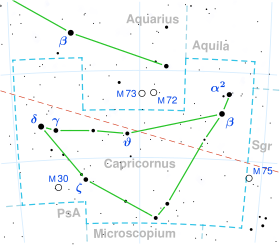| Observation data Epoch J2000.0 Equinox J2000.0 (ICRS) | |
|---|---|
| Constellation | Capricornus |
| ο Cap A | |
| Right ascension | 20h 29m 53.91117s[1] |
| Declination | −18° 34′ 59.4803″[1] |
| Apparent magnitude (V) | +5.94[2] |
| ο Cap B | |
| Right ascension | 20h 29m 52.59487s[1] |
| Declination | −18° 35′ 10.7447″[1] |
| Apparent magnitude (V) | +6.74[2] |
| Characteristics | |
| ο Cap A | |
| Spectral type | A1 V[3] |
| U−B color index | +0.30[2] |
| B−V color index | +0.08[2] |
| ο Cap B | |
| Spectral type | A7/8 V[3] |
| U−B color index | +0.04[2] |
| B−V color index | +0.22[2] |
| Astrometry | |
| ο Cap A | |
| Radial velocity (Rv) | −12.4±1.3[4] km/s |
| Proper motion (μ) | RA: +31.70[1] mas/yr Dec.: −83.18[1] mas/yr |
| Parallax (π) | 15.07 ± 4.14 mas[1] |
| Distance | approx. 220 ly (approx. 70 pc) |
| ο Cap B | |
| Radial velocity (Rv) | −9.1±0.6[4] km/s |
| Proper motion (μ) | RA: +33.31[1] mas/yr Dec.: −66.16[1] mas/yr |
| Details | |
| ο Cap A | |
| Mass | 2.05±0.20[5] M☉ |
| Luminosity | 18.6[5] L☉ |
| Surface gravity (log g) | 4.23[6] cgs |
| Temperature | 10,492±357[6] K |
| Rotational velocity (v sin i) | 276[7] km/s |
| Age | 118[6] Myr |
| ο Cap B | |
| Mass | 1.34±0.24[5] M☉ |
| Temperature | 7,762[5] K |
| Rotational velocity (v sin i) | 136[7] km/s |
| Other designations | |
| ο Cap A: BD−19° 5831, GC 28503, HD 195094, HIP 101123, HR 7830, SAO 163626[9] | |
| ο Cap B: BD−19° 5830, GC 28502, HD 195093, HIP 101120, HR 7829, SAO 163625[10] | |
| Database references | |
| SIMBAD | A |
| B | |
Omicron Capricorni (ο Capricorni) is a wide binary star[11] system in the constellation Capricornus.[12] The brighter component has an apparent visual magnitude of +5.94,[2] which is near the lower limit on stellar brightness that still can be seen with the naked eye. Based upon an annual parallax shift of 15.07 mas as seen from Earth,[1] this system is located roughly 220 light-years from the Sun. Large but uncertain discrepancies in the parallax measurements from Hipparcos may indicate, weakly, that there is a third, unseen companion in the system.[11]
Both visible components are white-hued A-type main-sequence stars.[3] The primary, component A, sometimes called ο1 Capricorni, has an apparent magnitude of +5.94, while the companion, component B or ο2 Capricorni, has an apparent magnitude of +6.74.[2] The two stars are currently separated by 21.91[11] arcseconds, corresponding to a projected separation of around 2,100 AU.[13] At the estimated age of around 118[6] million years old, both components are spinning rapidly: component A has a projected rotational velocity of 276 km/s, while component B is 136 km/s.[7]
- ^ a b c d e f g h i j Cite error: The named reference
vanLeeuwen2007was invoked but never defined (see the help page). - ^ a b c d e f g h Cite error: The named reference
Johnson1966was invoked but never defined (see the help page). - ^ a b c Cite error: The named reference
houk1978was invoked but never defined (see the help page). - ^ a b Cite error: The named reference
Gontcharov2006was invoked but never defined (see the help page). - ^ a b c d Cite error: The named reference
Zorec2012was invoked but never defined (see the help page). - ^ a b c d Cite error: The named reference
David2015was invoked but never defined (see the help page). - ^ a b c Cite error: The named reference
Royer2007was invoked but never defined (see the help page). - ^ Cite error: The named reference
SIMBADwas invoked but never defined (see the help page). - ^ Cite error: The named reference
SIMBAD_Awas invoked but never defined (see the help page). - ^ Cite error: The named reference
SIMBAD_Bwas invoked but never defined (see the help page). - ^ a b c Cite error: The named reference
Eggleton2008was invoked but never defined (see the help page). - ^ Harvard College Observatory (1941). Sky and Telescope. Stanford University.
- ^ Cite error: The named reference
Abt1988was invoked but never defined (see the help page).

